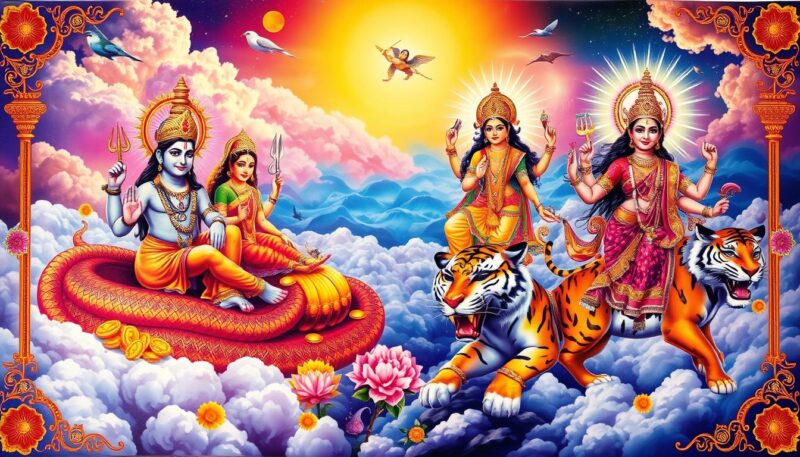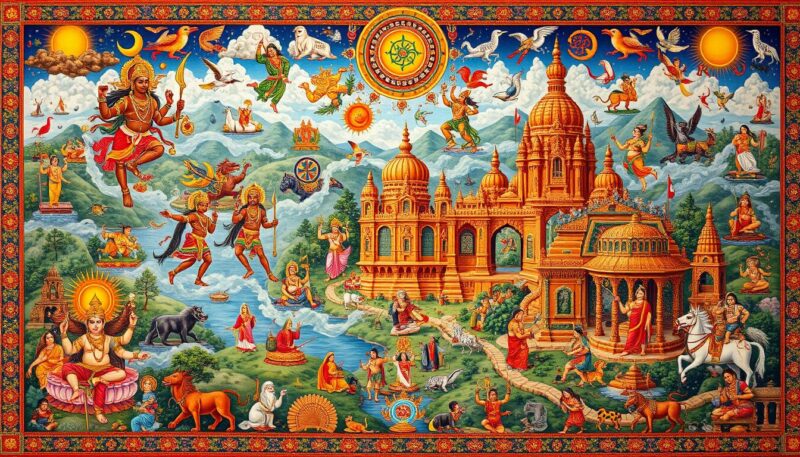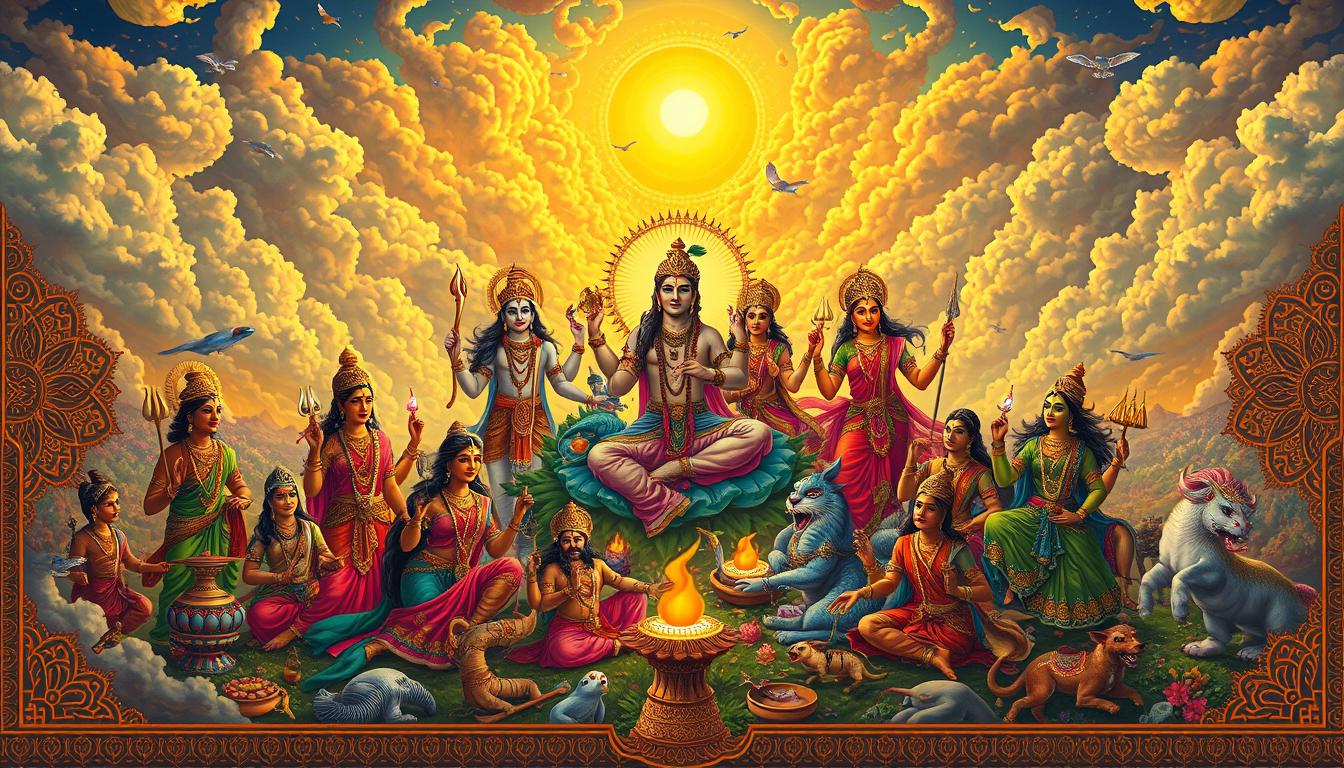Welcome to the fascinating realm of Indian mythology! This rich tapestry of divine beings, epic adventures, and profound moral lessons has captivated the human imagination for millennia. Drawing from ancient texts and oral traditions, these Indian mythology stories offer a deep exploration of human values, spirituality, and cosmic order. Through the characters from Indian mythology, we find narratives that guide us, teach us, and inspire us. Whether seen in mythology in art and literature or heard in traditional narratives in Indian culture, there is a perennial appeal to these timeless tales.
Key Takeaways
- Indian mythology is a blend of divine, heroic, and supernatural stories.
- Asuras, powerful beings, reflect both good and evil characteristics in Hindu lore.
- Mythology highlights moral lessons and cosmic order through its stories.
- Regional variations add rich diversity to Indian mythology.
- The belief in rebirth is central to Indian mythic traditions.
This journey into Indian mythology reveals much about the cultural and religious fabric of India. From the gods and heroes to the mythical creatures, the stories not only entertain but also provide deep insights into life and spirituality. These narratives continue to play a vital role in Indian culture, influencing modern-day art, literature, and even video games. So, sit back and let the legends of ancient India unfold before your eyes, offering wisdom that transcends time and space.
The Origins of Indian Mythology
Indian mythology is deeply rooted in ancient traditions, reflecting the profound impact of Vedic culture and ancient Indian scriptures. The seeds of these stories were sown between 2300 B.C and 1500 B.C, forming the foundation of what has evolved into one of the world’s richest mythological traditions. The Hindu religion traces its origins back to prehistoric times around 5000 to 10,000 B.C, with the Vedas being formulated between 1500 and 1000 B.C.
Ancient Texts and Traditions
The major Indian epics, the Ramayana and the Mahabharata, are among the oldest known epics in history, woven from the hymns, prayers, and narratives of the Vedas. The Mahabharata, written between 400 B.C and 200 A.D, and the Ramayana, dating back to an undefined ancient era, encapsulate the essence of early Indian mythological thought. These texts not only serve as cultural treasures but also impart moral values still revered today. The ancient Indian scriptures, like the Rigveda, Yajurveda, Samaveda, and Atharvaveda, capture a unique blend of mythology, philosophy, and science, influencing a broad spectrum of life.
The Impact of Vedic Culture
Vedic culture significantly shaped social, spiritual, and religious practices. Aryan migrations spread Hindu beliefs across regions, influencing languages like Sanskrit and Pali. The period’s distinct contribution includes defining the structure of society through the caste system and establishing essential rituals still observed today. Key Vedic deities such as Agni, Chandra, and Indra, along with post-Vedic deities like Ganesha and Krishna, illustrate the complex array of celestial beings in Indian mythology. The ethical principles in Hinduism, such as Yamas and Niyama, were formalized during this era, reinforcing the importance of leading a righteous life.
| Yuga | Duration (Human Years) | Description |
|---|---|---|
| Satya Yuga | 1,728,000 | The golden age; humans are around 31.5 feet tall. |
| Treta Yuga | 1,296,000 | The age depicted in the Ramayana. |
| Dwapar Yuga | 864,000 | The age depicted in the Mahabharata; Bronze Age. |
| Kali Yuga | 432,000 | Current age; Iron Age. |
Significant Gods and Goddesses
Hindu mythology boasts an extensive pantheon of divine beings, each embodying diverse aspects of life and the universe. The concept of one Ultimate Reality, manifested through numerous deities of Hinduism, forms the cornerstone of Hindu belief. This section delves into the stories of Indian gods and their significant roles in worship and daily life.

Among the most venerated of all Hindu gods and goddesses is Ganesha, revered across all sects. Ganesha, the elephant-headed god, is widely respected as the remover of obstacles and the patron of arts and sciences. His ubiquitous presence in households and temples reflects his significance in the worship of Indian deities.
Rama, another eminent deity, is celebrated as the perfect embodiment of humankind. His heroic journey, chronicled in the ancient epic Ramayana, reflects ideals of righteousness, devotion, and duty. Rama’s historicity, widely believed, bridges divine mythology with human experience, making him a pivotal figure among Hindu gods and goddesses.
Vishnu, the Preserver, is central to Vaishnavism, one of Hinduism’s major traditions. Believers, known as Vaishnavas, pray to Vishnu for maintenance of cosmic order. According to stories of Indian gods, Vishnu incarnates during times of chaos to restore peace, with avatars like Krishna and Rama being vital manifestations.
Alongside Vishnu stands his consort, Lakshmi, the goddess of wealth and prosperity. She is revered in many Hindu households for her blessings of fortune and purity. Her stories intertwine with major religious narratives, underscoring her importance in Hindu worship.
Shiva, the Destroyer, is indispensable in the Hindu trinity. Known for his cosmic dance of destruction, Shiva paves the way for new creation. Among Shaivites, his devotees, Shiva’s power signifies transformation and renewal. His consort, Parvati, embodies fertility, love, and devotion, complementing Shiva’s transformative force.
Goddesses like Durga and Kali also hold paramount importance. Durga, the fierce protector, symbolizes the victory of good over evil. She is commonly depicted astride a lion, wielding weapons to combat demonic forces. Kali, the darker aspect of Parvati, represents time and change, her fearsome demeanor signifying the cyclical nature of existence.
Saraswati, the goddess of knowledge, art, and music, is venerated as the mother of the Vedas. Her wisdom endows humans with the powers of speech and intellect. She holds a distinctive place in the pantheon, especially celebrated during the festival of Saraswati Puja.
Brahma, the Creator, although less worshiped in contemporary Hinduism, forms one-third of the essential Trimurti. His role as the progenitor of knowledge, associated with Saraswati, showcases his contribution to cosmic genesis and wisdom.
| Deity | Role | Significance in Worship |
|---|---|---|
| Ganesha | Remover of Obstacles | Worshiped by all sects |
| Rama | Perfect Human Embodiment | Epic hero, historical figure |
| Vishnu | Preserver | Supreme god for Vaishnavas |
| Lakshmi | Goddess of Wealth | Key household deity |
| Shiva | Destroyer | Transformational force |
| Saraswati | Goddess of Knowledge | Embodiment of wisdom |
The rich tapestry of deities of Hinduism is not just a testament to devotional diversity but also a reflection of the multifaceted nature of life itself. By understanding and venerating these Hindu gods and goddesses, you embrace the timeless principles they symbolize and the profound teachings they impart.
Heroic Legends and Folklore
In the rich tapestry of legends and folklore that define Indian mythology, the stories of heroes and demons stand out as timeless narrations of valor, virtue, and the cosmic balance of power. One of the most celebrated heroic stories in India revolves around Indra, the king of the heavens, who triumphed over Asuras such as Vritra and Bhasmasura. This legendary conflict exemplifies the eternal struggle between good and evil, a common theme in mythology and spirituality.
The fascinating saga of Indra defeating Vritra, the serpent demon, underscores the prevailing notion of righteous duty and divine guardianship. Vritra, known for causing droughts, was slain by Indra, symbolizing the heroic effort to restore natural order and prosperity. These tales not only portray the might of the gods but also introduce you to the complexities of mythology and spirituality, where each character’s traits and actions hold deeper symbolic meanings.
Moreover, the transformation of Asura Bhasmasura, whose touch could turn any being to ashes, encapsulates the intriguing dynamics within legends and folklore. His ultimate defeat by Lord Vishnu, who appeared as the enchanting Mohini, demonstrates the recurring motif of cunning and strategic wisdom prevailing over brute force in heroic stories in India.
| Aspect | Indra’s Story | Bhasmasura’s Tale |
|---|---|---|
| Hero | Indra | Lord Vishnu (as Mohini) |
| Villain | Vritra | Bhasmasura |
| Theme | Righteousness and Order | Wisdom Over Force |
The tales of divine conflicts, celestial interventions, and miraculous rescues serve as profound allegories within Indian mythology and spirituality. Through these heroic stories in India, you gain insight into cultural values, moral dilemmas, and the resilient spirit celebrated across epochs. Embracing these narratives allows you to appreciate the legacy of legends and folklore that continue to inspire and shape the spiritual ethos of India.
Characters and Their Symbolism
In the vast panorama of Indian mythology, characters wield significant symbolic power. Deeply rooted in the significance of mythology in India, these characters embody profound philosophical concepts such as Dharma, Karma, and reincarnation. Hinduism, believed to have started around 2300 B.C. – 1500 B.C., intricately weaves the lives and actions of its deities into the philosophical fabric of the society.

Significance of Gods and Goddesses
Among the pantheon of gods, Indra, the most significant deity during the Vedic Period (1500 B.C. – 500 B.C.), was revered for his portrayal of strength and valor. Likewise, Agni, hypothesized to be the second most important deity after Indra, symbolizes the sacred fire and the transformative power of rituals. As Hindu mythology evolved during the Epic, Puranic, and Classic Periods (500 B.C. – A.D. 500), gods like Vishnu, represented as the preserver, and Shiva, the destroyer, became central figures, contributing to the cultural impact of mythology.
Goddesses, too, bear immense significance. Lakshmi, representing wealth and prosperity, Durga as a protector, and Saraswati, the embodiment of knowledge, each highlight different aspects of life and spirituality. Their stories, rich in metaphor and symbolism, have influenced Hindu cultural practices and traditions for millennia.
Representation in Art and Literature
The mythology in art and literature plays a pivotal role in preserving and propagating the rich narratives of these characters. From the intricate carvings in ancient temples to the vivid imagery in modern paintings, representations of gods and goddesses are a testament to their enduring legacy. Literature, from the Vedas to contemporary works, often explores these deities’ multifaceted personas, intertwining their divine qualities with human experiences.
In addition to traditional Indian art, the metaphorical significance of these characters is evident in global artistic expressions. Items such as gourds and other symbols in literature highlight the mutual influences between cultures. Through centuries, the stories shared in mythology not only serve as religious texts but also as cultural blueprints, guiding moral conduct and societal values.
Understanding these characters’ symbolism underscores the essential significance of mythology in India. It highlights how mythology serves as a bridge between the divine and the mortal, offering insight into the complexities of life’s journey.
Interesting Facts About Indian Mythology
Indian mythology offers a treasure trove of mythology and moral lessons that resonate deeply in the cultural fabric of India. These stories, tracing back to as far as 5000 – 10,000 BC, not only depict divine and heroic feats but also embed ethical and philosophical teachings that continue to influence societal values. The principles of ‘Dharma’ (righteousness) and ‘Karma’ (action and reaction) are central elements prominently woven into these myths.
Mythology and Moral Lessons
One cannot delve into Indian mythology without encountering the profound mythology and moral lessons that are core to its narratives. Stories like the Mahabharata and Ramayana exemplify the triumph of good over evil. The Vedas, composed around 1500 BCE, contain hymns that echo these timeless truths, reflecting on cosmic order and the inherent duties of individuals. In these texts, you’ll find elaborate descriptions of divine weapons, battles, and heroic deeds, all underscoring the importance of living a life led by principles.
Regional Variations
The richness of Indian mythology is further embellished by regional variations in mythology, adding depth and diversity to the cultural expression. Local legends and deities uniquely influence various regions, resulting in myriad interpretations and retellings of central myths. For instance, while the worship of Shiva as the God of destruction and renewal is prominent across India, regional tales may highlight different aspects of his persona. Additionally, various creatures like Gandharavas, Kinnaras, and Nagas populate these stories, showcasing the vibrant diversity of characters across different locales.
These regional variations in mythology ensure that no two versions of a story are exactly the same, celebrating the vast cultural tapestry of India. Whether it’s the epic confrontations between gods and demons or the symbolic representations found in art and literature, these regional nuances add layers of meaning and context to the broader narrative.
| Aspect | Central Narrative | Regional Variations |
|---|---|---|
| Principal God | Shiva, Goddess Durga | Local deities like Khandoba in Maharashtra or Ayyanar in Tamil Nadu |
| Key Moral Lesson | Dharma (Righteousness) | Localized folklore emphasizing community-centric virtues |
| Epic Battles | Mahabharata, Ramayana | Regional epics and oral traditions |
| Divine Creatures | Apsaras, Gandharavas | Regional beings like Yakshas in North India or Teyyam in Kerala |
Thus, the intricate tapestry of Indian mythology, marked by mythology and moral lessons and its regional variations in mythology, offers an endless exploration of life’s profound truths and cultural richness.
Conclusion
Exploring Indian mythology opens a profound window into a rich cultural heritage that has captivated millions for centuries. By delving into the origins of Indian mythology, we gain insight into ancient texts like the Vedas, foundational to understanding this spiritual tradition that dates back to 1500 BCE. From the creation stories within the Rig Veda to the epics of the Mahabharata and Ramayana, these texts encapsulate the essence of Indian heroes and their timeless journeys.
Understanding Indian heroes such as Rama, Arjuna, and Krishna provides a unique lens through which you can appreciate the cultural impact of mythology on modern society. These divine figures embody moral values and philosophical lessons that continue to resonate with spiritual seekers around the globe. Their tales of bravery, virtue, and sacrifice aren’t merely relics of the past but serve as guiding lights in contemporary moral discourse.
The vast pantheon of gods and goddesses in Hindu mythology also underscores the depth and complexity of Indian spirituality. Deities like Brahma, Vishnu, and Shiva symbolize creation, preservation, and destruction, respectively, portraying the cyclical nature of the universe. The cultural impact of mythology manifests vividly through these symbols, influencing the arts, literature, and daily life in India and beyond. With nearly one billion adherents globally, Hinduism stands as a testament to the enduring power of its myths and legends.
In essence, Indian mythology is more than a collection of fascinating tales; it is a living, evolving narrative that continues to educate, inspire, and provide moral clarity. The stories of gods, heroes, and legendary figures transcend time, holding relevance in both historical and modern contexts. As you continue to explore and understand these myths, you join a long tradition of seekers who draw on the rich cultural tapestry of Indian mythology to find meaning and purpose in the mysteries of life.
FAQ
What are some of the most interesting facts about Indian mythology?
Indian mythology is a treasure trove of captivating stories featuring gods, heroes, and legendary figures. It offers profound moral lessons and reflects the cultural and spiritual beliefs of India. Stories from the Ramayana and Mahabharata, for example, not only entertain but also convey essential values such as duty, loyalty, and righteousness.
How did Indian mythology originate?
Indian mythology traces its origins back to between 2300 B.C and 1500 B.C with the foundational role of the Vedas and other ancient scriptures. The Aryans’ influence, along with the spread of Hindu beliefs through migration and trade, significantly shaped these mythological tales.
What is the significance of Vedic culture in Indian mythology?
Vedic culture profoundly impacted Indian mythology by influencing the caste system, temple worship, and the importance of sacred rituals. These ancient traditions laid the groundwork for the moral and ethical frameworks that continue to resonate in Indian society today.
Who are some of the significant gods and goddesses in Indian mythology?
Indian mythology features a rich pantheon of gods and goddesses, each embodying different aspects of life and the universe. Prominent deities include Brahma, the creator; Vishnu, the preserver; Shiva, the destroyer; and goddesses like Saraswati, Lakshmi, and Parvati, each associated with unique qualities and roles in religious practice.
What are some heroic legends and folklore in Indian mythology?
Indian mythology is replete with heroic tales and folklore that highlight the powers of gods, demons, and mythical creatures. Stories of Indra, the hero who rose to power, and Asuras like Andhaka and Bhasmasura illustrate the complex nature of these beings and their significance in the mythological narrative.
What is the symbolism associated with characters in Indian mythology?
Characters in Indian mythology often symbolize profound philosophical concepts such as Dharma (righteousness), Karma (action and reaction), and reincarnation. Deities like Lakshmi represent divine qualities, and their depictions in art and literature emphasize these attributes’ cultural and ethical importance.
How is Indian mythology represented in art and literature?
Indian mythology has greatly influenced art and literature, with stories and characters depicted in various forms from ancient temple carvings to modern paintings and literary works. These representations help convey the moral and spiritual lessons embedded in the myths, making them more accessible to people across generations.
How do mythology and moral lessons intertwine in Indian stories?
The stories in Indian mythology often come with embedded moral lessons, prominently featuring concepts like Dharma and Karma. These narratives have shaped the ethical frameworks in Indian society, teaching values such as righteousness, duty, and the consequences of one’s actions.
What are some regional variations in Indian mythology?
Indian mythology is diverse and rich with regional variations, each adding unique interpretations and stories. Different regions in India have their folk tales and myths, contributing to the overall complexity and richness of Indian cultural expression.
What influence has Indian mythology had on culture and society?
Indian mythology has profoundly impacted art, society, and moral values. Its stories have shaped cultural practices, ethical frameworks, and spiritual beliefs. The enduring legacy of these myths continues to inspire and educate, reflecting the intertwined relationship between myth and everyday life in India.
Source Links
- https://mythology.net/hindu/hindu-creatures/asura/
- https://folklorethursday.com/myths/again-and-again-in-indian-mythology/
- https://dhaaramagazine.in/2020/08/28/indian-mythology-the-cornerstone-of-indian-music/
- https://www.ancienthistorylists.com/india-history/top-10-interesting-hindu-mythology/
- https://en.wikipedia.org/wiki/Hindu_mythology
- https://www.learnreligions.com/top-hindu-deities-1770309
- https://historycooperative.org/hindu-gods-and-goddesses/
- https://en.wikipedia.org/wiki/List_of_Hindu_deities
- https://historycooperative.org/hindu-mythology/
- https://theculturetrip.com/asia/india/articles/8-fascinating-indian-myths-and-legends
- https://www.history.com/topics/religion/hinduism
- https://www.realmofhistory.com/2018/09/18/major-hindu-gods-goddesses-facts/
- https://www.askganesha.com/blog/interesting-facts-about-hindu-mythology
- https://www.ganeshaspeaks.com/predictions/astrology/interesting-facts-about-hindu-mythology/
- https://pandasbox.in/blogs/news/interesting-facts-on-indian-mythology?srsltid=AfmBOorWP16czntNDJspU4ZivmgUjmXZnogAfHvY9JGMVftCTs9vaCFn
- https://www.britannica.com/topic/Hinduism
- https://astrotalk.com/astrology-blog/know-some-interesting-facts-about-hindu-mythology-insideastro-iajj-7/
- https://www.mypandit.com/spirituality/hinduism/interesting-facts-about-hindu-mythology/?srsltid=AfmBOopNSCgxuUc4AvkzRWRAJ3964_drH8XmmPiI5eduaD4lcJu63Yz8

